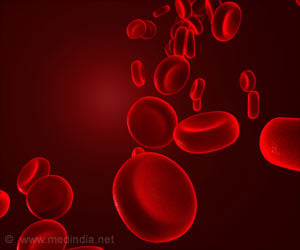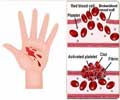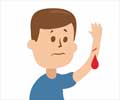- Haemorrhagic Diathesis - (http://intranet.tdmu.edu.ua/data/kafedra/internal/propedeutic_vn_des/classes_stud/en/stomat/ptn/Internal%20medicine/4/Lesson_08_%20Haemorrhagic%20Diathesis.htm)
- Prothrombin time test - (https://www.mayoclinic.org/tests-procedures/prothrombin-time/details/results/rsc-20163828)
- Bleeding Disorders: Hemorrhagic Diatheses - (http://jpck.zju.edu.cn/jcyxjp/files/ge/03/MT/0355.pdf)
- Therapeutic plasma exchange (TPE) - (https://www.transfusionguidelines.org/transfusion-handbook/11-therapeutic-apheresis/11-1-therapeutic-plasma-exchange-tpe)
- Bleeding diathesis in multiple myeloma - (https://www.ncbi.nlm.nih.gov/pubmed/11672511)
- How do you treat bleeding disorders with desmopressin? - (https://www.ncbi.nlm.nih.gov/pmc/articles/PMC2599976/)
What is Bleeding Diathesis?
Bleeding or hemorrhagic diathesis represents a group of bleeding disorders characterized by an increased tendency of the body to bleed or hemorrhage. The bleeding could occur very easily, without any obvious triggering event or injury. Spontaneous bleeding from the nose, mouth or digestive tract may not indicate any serious condition; but sometimes it can be severe enough to be life-threatening.
Normally when a person gets injured and bleeding occurs, a blood clot is formed to stop the bleeding. There are several substances present in the body, like platelets and clotting factors that aid in this process. When there is a bleeding disorder, the clotting mechanism fails due to several reasons.
Causes and Classification of Bleeding Diathesis
Bleeding diathesis can result from a number of reasons which include increased fragility of blood vessels, impaired wound healing, platelet deficiency or dysfunction, thinning of skin, coagulation, or a combination of these. Bleeding disorders can be inherited (passed on from parent to child) or acquired in your lifetime.
There are three main components that are intrinsic to help the blood clot. They are:
- Platelets (a blood cell type that helps in blood clotting)
- Blood clotting factors (proteins that are largely produced by the liver but also by certain cells that line the blood vessels)
- Blood vessel narrowing or constriction
Hence the causes of bleeding and bruising are attributed to abnormalities in platelets, clotting factors or blood vessels.

A. Platelet disorders have symptoms that start of as small red or purple dots on the skin that lead to severe bleeding.
Platelet disorders in turn can be due to:
- Decreased number of platelets or severe platelet deficiency: this decrease can be due to inadequate production of platelets by the bone marrow or excessive destruction of platelets. Reasons for this are:
- Aplastic anemia
- Cirrhosis if the spleen is enlarged
- Disseminated intravascular coagulation (DIC) that occurs when certain conditions like severe infections, severe injury, labor and delivery, and certain cancers trigger the clotting system throughout the body; in such circumstances, platelets and clotting factors are quickly used up and bleeding occurs. These patients bleed easily and excessively from needle punctures and often have significant digestive tract bleeds.
- Drugs that can trigger destruction of platelets (including heparin, quinidine, quinine, sulfonamides, sulfonylureas, or rifampin)
- Hemolytic-uremic syndrome, abbreviated HUS, is a disease characterized by a triad of three conditions, namely, hemolytic anemia or anemia caused by destruction of red blood cells, acute kidney failure or uremia, and a low platelet count or thrombocytopenia. It predominantly affects children.
- HIV infection, immune thrombocytopenia
- Leukemia
- Thrombotic thrombocytopenic purpura (TTP) is a rare blood disorder where blood clots are formed in small blood vessels throughout the body. The clots can limit or block the flow of oxygen-rich blood to the body's organs, such as the brain, kidneys, and heart.
- Increased number of platelets: this condition mostly causes excessive clotting but can sometimes cause excessive bleeding:
- Inadequate or functional disorder of platelet function can be inherited (rare) or acquired (common).
- Inherited
- Disorders of platelet adhesion like Von Willebrand’s disease and Bernard-Soulier syndrome
- Disorders of platelet aggregation like Glanzmann’s thrombasthenia
- Storage pool disease – gray platelets
- Acquired
- Drugs (including aspirin or other NSAIDs and alcohol)
- Myelodysplastic syndrome (MDS) are a group of closely related blood disorders commonly found in the aging population
- Multiple myeloma – cancer of a plasma cell
- Uremia
B. Clotting disorders occur when there is a decreased activity of blood clotting factors which are proteins largely produced by the liver and by certain cells that line blood vessels. A decrease in blood clotting factors usually causes bleeding and bruising. Clotting disorders can again be classified as acquired or inherited.
Acquired disorders occur due to:
Consuming anticoagulants (drugs that inhibit clotting) including heparin, warfarin, or direct oral anticoagulants (DOACs) (including dabigatran, apixaban, edoxaban, and rivaroxaban)
DIC if it progresses slowly
Liver disease (the liver is a major site of blood clotting factor production, and helps to regulate blood clotting, and so people with liver disease (for example, hepatitis or cirrhosis) have a tendency to bleed easily)
Vitamin K deficiency
Antibodies against factor VIII (or other factors)
Massive transfusion
Hereditary disorders occur due to
Hemophilia, a hereditary disorder in which the body does not make enough of certain clotting factors. People have excessive bleeding into deep tissues such as muscles, joints, and the back of the abdominal cavity, usually following minor trauma.
In hemophilia A, there is not enough clotting factor VIII, while in hemophilia B, there is not enough clotting factor IX.
Von Willebrand disease that occurs due to a deficiency in the quality or quantity of von Willebrand factor (vWF), that is required for platelet adhesion.
Rare factor disorders like deficiencies in factors I, II, V, VII, X, XI (mostly in Ashkenazi Jews), XII and XIII
C. Vascular bleeding disorders are characterized by easy bruising and spontaneous bleeding from small vessels. Defects in blood vessels manifest as red or purple spots and patches on the skin, rather than bleeding. The underlying abnormalities are either in the vessels themselves or in the perivascular connective tissue.
Acquired: Immunoglobulin A–associated vasculitis, vitamin C deficiency, certain infections, steroid purpura, thinning of the skin as in Cushing’s syndrome.
Hereditary: Connective tissue disorders (such as Marfan syndrome and Ehlers-Danlos syndrome), hereditary hemorrhagic telangiectasia (rare autosomal dominant genetic disorder) and hemangiomas (noncancerous growths of blood vessels).
What are the Symptoms and Signs of Bleeding Diathesis?
Commonly observed manifestations and clinical features of bleeding diathesis are:
- Red spots or petechiae
- Anemia which makes one feel tired or weak
- Spontaneous or recurrent bruising
- Large bruises from minor injuries or excessive and prolonged bleeding after an injury, surgery or dental work
- Prolonged nosebleeds
- Blood in stool or urine
- Bleeding after injections or a surgery
- Purpura and ecchymoses- In case of acute and chronic leukemia and vitamin k deficiency
- Bleeding into joints, muscles, and organs (indicates hemophilia)
- Bleeding gums
- Severe menorrhagia or menstrual bleeding causing anemia
- Heavy vaginal bleeding due to other reasons like endometriosis

How do you Diagnose Bleeding Diathesis?
There are five studies which are important to the diagnosis of bleeding disorders which include:
- Bleeding time (BT) - This test is used to assess the function of platelets in human body. It measures the time taken for a standardized skin puncture (specifically called Duke Method) to stop bleeding which is comparable to a vascular injury. The reference range varies from 2-9 minutes. Prolonged bleeding generally indicates a platelet aggregation defect. Another traditional method known as the IVY method is also used but is a more invasive method. It utilizes an incision on the ventral side of the forearm. Generally, patients with Von Willebrand disease have prolonged bleeding time despite a normal platelet count. Also, delayed bleeding from the umbilical stump is characteristic of a factor XIII deficiency.
- Platelet count - A platelet count test is used to detect the number of platelets in the blood. The normal number of platelets in the blood is 150,000 to 400,000 platelets per microliter (mcL) and in case of low platelet count(also called as thrombocytopenia) this value is below 50,000 (50 × 109/L). These counts are obtained on anticoagulated blood using an electronic particle counter. High platelet counts are indicative of a myelo proliferative disorder.
- Prothrombin time test (PT) - This test measures the amount of time taken by blood plasma to clot. Prothrombin (also called factor II), is a plasma protein involved in the clotting process. The clotting of plasma after addition of an exogenous source of tissue thromboplastin and Ca2+ ions is measured in seconds. The reference time range for blood to clot is about 10-14 seconds. A prolonged PT indicates deficiency or dysfunction of factor V, factor VII, factor X, prothrombin, or fibrinogen.
- Partial or Activated partial thromboplastin time (PTT or aPTT) - This test characterizes blood coagulation and detects abnormalities in blood clotting. The clotting of plasma is observed after the addition of kaolin, cephalin, and calcium ions. The reference range of the aPTT is 30-40 seconds and PTT is 60-70 seconds. Kaolin which is a surface activator serves to activate the contact-dependent factor XII, and cephalin substitutes for platelet phospholipids. Prolongation of the PTT indicates deficiency or dysfunction of factor V, VIII, IX, X, XI, or XII, prothrombin, fibrinogen and prekallikrein. The aPTT is actually a more sensitive version of the PTT that helps assess patient’s response to heparin therapy.
- Prothrombin Time (PT) - This test is used to measure the time necessary to generate fibrin after activation of factor VII. It measures the integrity of the extrinsic and common pathways that includes factors VII, V, X, prothrombin, and fibrinogen.
- Test of fibrinolysis - This test utilizes fibrin degradation products (FDP) as a marker of fibrinolysis. It can be quantified by a test based on latex agglutination. This test indicates increased fibrinolysis in case of brain trauma, chronic bleeding, vascular thrombosis, prostate surgery, and uterine disorders.

What are the Complications of Bleeding Disorders?
Complications associated with bleeding disorders can be mostly prevented or controlled with treatment. But, if they are not treated on time, they can lead to severe complications
- Central nervous system hemorrhage
- Bleeding in the intestines
- Soft tissue bleeding
- Transfusion transmitted infection
- Joint bleeding
- Joint pain
How do you Treat Bleeding Diathesis?
Iron Supplementation
As there is a significant loss of iron during bleeding diathesis, iron supplements may be used to replenish the amount of iron in the body. Low iron levels or its deficiency can result in iron deficiency anemia. In cases where iron supplements do not work, blood transfusions should be used to compensate for the excessive blood loss.
Blood Transfusion
A blood transfusion is also a valuable option in treating uncontrolled hemorrhagic condition. It replaces any blood loss by receiving blood from a donor. The donor and recipient blood are matched first to prevent any complications.

Platelet Transfusion
In case of thrombocytopenia which occurs as a result of reduced platelet production, platelet transfusion is a good option. A patient suffering from autoimmune thrombocytopenia needs large amounts of platelets to boost the platelet count. Also, a concomitant administration of immune-modulating therapies such as steroids or intravenous immunoglobulins may also help in rapid increase of platelet count.
Therapeutic Plasma exchange therapy (TPE)
TPE is a treatment that removes plasma from the blood which is then replaced with a substitute. It helps remove large-molecular-weight substances such as harmful antibodies from the plasma. It utilizes automated blood cell separator to ensure fluid balance and maintain a normal plasma volume during the procedure. It is of particular use in conditions like thrombotic thrombocytopenic purpura and atypical hemolytic uremic syndrome.
Other Treatments:
Other treatment methods are also considered while treating hemorrhagic diathesis.
Nasal products or nasal sprays- E.g. Oxymetazoline nasal spray
Antifibrinolytic agents- E.g aminocaproic Acid, tranexamic Acid, desmopressin. Desmopressin is shown to exert a substantial hemostatic effect by inducing the release of von Willebrand factor. It is used to treat or prevent the condition in patints with Von Willebrand disease, hemophilia A and some platelet function defects.
Fresh frozen plasma transfusions- If a patient lacks certain clotting factors like factors V and VIII then transfusion of fresh frozen plasma is a good option.
Health Tips
- Any medication that is likely to impair hemostatic function should be avoided for e.g. aspirin and NSAIDs.
- Certain conditions like untreated severe hypertension may lead to intracranial bleeding; so these patients must pay more attention to control their condition.
- Consultation with a hematologist should be necessarily taken before any invasive procedure.











